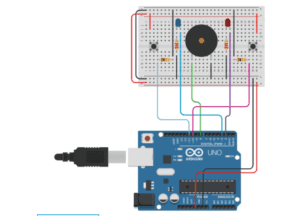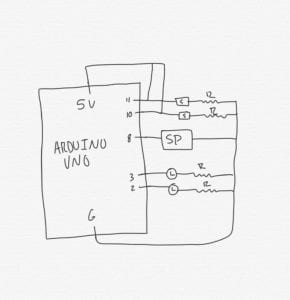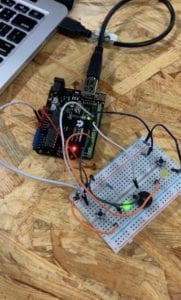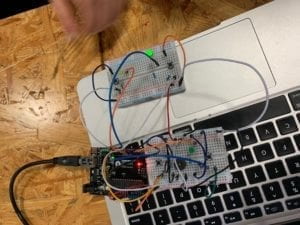February 25th, 2019
Materials:
- Arduino Uno
- USB A to B cable
- Breadboard
- Buzzer
- LEDs
- 220-ohm resistors
- 10K-ohm resistors
- Pushbuttons
- A handful of jumper cables
Circuit 1: Fade

Circuit 1 Diagram
Circuit 1
Since we have become more comfortable reading schematics for simpler circuits, we were able to build the circuit fairly quickly. After uploading the code and trying it the first time, we found that the LED was really dim. But it did noticeably fade as planned. We at first thought it was something wrong with the LED itself, but it turned out we had the wrong resistor in. After switching out the 10K resistor with a 220 resistor, the circuit worked perfectly.
Circuit 2: toneMelody

Circuit 2 Diagram
Circuit 2
Building this circuit was really easy because it only required a buzzer, leaving no room for us to use the wrong resistor this time. It worked the first time we uploaded the code onto the Arduino Uno board.
Circuit 3: Speed Game

Circuit 3 Tinkercad

Circuit 3 Schematic

Circuit 3
This circuit looked a little daunting when we started. After digesting the instructions and the pictures given on Tinkercad we were able to build the circuit. After putting everything together, we thought we did something wrong in our wiring because nothing was happening when we pressed any of the buttons. But it wasn’t anything wrong with the circuit itself, we had just forgotten to use the serial monitor to start the game. The Speed Game was then fully operational.
Circuit 4: 4-Player Speed Game

Circuit 4
Once finding another group to team up with, we started working on the code. We basically copied the parts that had something for “player 1” and “player 2” and added two more players. Then we connected two breadboards, one having just LEDs and buttons, and uploaded our code. It worked the first try.
Question 1:
Today, its almost impossible to function without some sort of connection to technology. I can’t think of anyone I know who doesn’t come in contact with some sort of computer on a daily basis. There are many purposes and jobs these devices and programs serve, but they all run on the same simple principle of input and output. By building these circuits, we can see it very clearly when we input code and an output, like a flashing light or a tune playing, is the result. And interaction is the loop of inputting some form of information or command that returns an output based on the input.
Question 2:
I’d want to create an art installation that would make it seem like you’re walking through the stars. It’d be a large room that would give the illusion of being endless like outer space itself. I’m not sure where I’d want to put it, just somewhere many people would be able to experience it. It’d be simplistic but beautiful and calming to be in.